Exercise effects on motor and affective behavior and catecholamine neurochemistry in the MPTP-lesioned mouse
- PMID: 20472000
- PMCID: PMC2902645
- DOI: 10.1016/j.bbr.2010.05.009
Exercise effects on motor and affective behavior and catecholamine neurochemistry in the MPTP-lesioned mouse
Abstract
This study used 1-methyl-4-phenyl-1,2,3,6,-tetrahydropyridine (MPTP) in mice to determine if exercise improves behavior and dopamine (DA) and serotonin (5HT) content. Male C57BL/6 mice received MPTP (4 x 20mg/kg) or saline. They remained sedentary or exercised by treadmill or voluntary running wheel for 6 weeks (n=8/group). Saline-treated mice ran significantly faster on running wheels (22.8+/-1.0m/min) than on treadmill (8.5+/-0.5m/min), and MPTP lesion did not reduce voluntary exercise (19.3+/-1.5m/min, p>0.05). There was a significant effect of both lesion and exercise on overall Rotarod performance (ORP): MPTP lesion reduced ORP, while treadmill exercise increased ORP vs sedentary mice (p<0.05). MPTP increased anxiety in the marble-burying test: sedentary lesioned mice buried more marbles (74.0+/-5.2%) than sedentary controls (34.8+/-11.8%, p<0.05). Conversely, exercise reduced anxiety on the elevated plus maze. Among saline-treated mice, those exposed to voluntary wheel-running showed an increased percent of open arm entries (49.8+/-3.5%, p<0.05) relative to sedentary controls (36.2+/-4.0%, p<0.05). Neither MPTP nor exercise altered symptoms of depression measured by sucrose preference or tail suspension. MPTP significantly reduced DA in striatum (in sedentary lesioned mice to 42.1+/-3.0% of saline controls), and lowered 5HT in amygdala and striatum (in sedentary lesioned mice to 86.1+/-4.1% and 66.5+/-8.2% of saline controls, respectively); exercise had no effect. Thus, exercise improves behavior in a model of DA depletion, without changes in DA or 5HT.
Copyright (c) 2010 Elsevier B.V. All rights reserved.
Figures
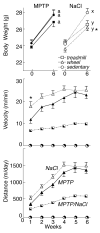
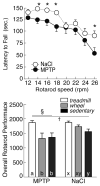
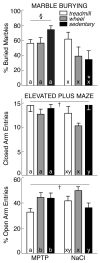
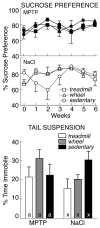
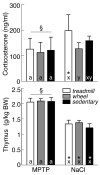


Similar articles
-
Effects of treadmill exercise on dopaminergic transmission in the 1-methyl-4-phenyl-1,2,3,6-tetrahydropyridine-lesioned mouse model of basal ganglia injury.J Neurosci. 2007 May 16;27(20):5291-300. doi: 10.1523/JNEUROSCI.1069-07.2007. J Neurosci. 2007. PMID: 17507552 Free PMC article.
-
Running wheel activity restores MPTP-induced functional deficits.J Neural Transm (Vienna). 2011 Mar;118(3):407-20. doi: 10.1007/s00702-010-0474-8. Epub 2010 Sep 18. J Neural Transm (Vienna). 2011. PMID: 20852902
-
The yeast product Milmed enhances the effect of physical exercise on motor performance and dopamine neurochemistry recovery in MPTP-lesioned mice.Neurotox Res. 2013 Oct;24(3):393-406. doi: 10.1007/s12640-013-9405-4. Epub 2013 Jul 27. Neurotox Res. 2013. PMID: 23893731
-
The intranasal administration of 1-methyl-4-phenyl-1,2,3,6-tetrahydropyridine (MPTP): a new rodent model to test palliative and neuroprotective agents for Parkinson's disease.Curr Pharm Des. 2011;17(5):489-507. doi: 10.2174/138161211795164095. Curr Pharm Des. 2011. PMID: 21375482 Review.
-
alpha-Synuclein- and MPTP-generated rodent models of Parkinson's disease and the study of extracellular striatal dopamine dynamics: a microdialysis approach.CNS Neurol Disord Drug Targets. 2010 Aug;9(4):482-90. doi: 10.2174/187152710791556177. CNS Neurol Disord Drug Targets. 2010. PMID: 20522009 Review.
Cited by
-
Voluntary Physical Exercise Improves Subsequent Motor and Cognitive Impairments in a Rat Model of Parkinson's Disease.Int J Mol Sci. 2018 Feb 8;19(2):508. doi: 10.3390/ijms19020508. Int J Mol Sci. 2018. PMID: 29419747 Free PMC article.
-
Exercise offers anxiolytic potential: a role for stress and brain noradrenergic-galaninergic mechanisms.Neurosci Biobehav Rev. 2012 Oct;36(9):1965-84. doi: 10.1016/j.neubiorev.2012.06.005. Epub 2012 Jul 5. Neurosci Biobehav Rev. 2012. PMID: 22771334 Free PMC article. Review.
-
Sex differences in drug addiction and response to exercise intervention: From human to animal studies.Front Neuroendocrinol. 2016 Jan;40:24-41. doi: 10.1016/j.yfrne.2015.07.001. Epub 2015 Jul 13. Front Neuroendocrinol. 2016. PMID: 26182835 Free PMC article. Review.
-
Cortical Synaptic Mechanism for Chronic Pain and Anxiety in Parkinson's Disease.J Transl Int Med. 2023 Jan 13;10(4):300-303. doi: 10.2478/jtim-2022-0046. eCollection 2022 Dec. J Transl Int Med. 2023. PMID: 36860635 Free PMC article. No abstract available.
-
Gonadal hormones and voluntary exercise interact to improve discrimination ability in a set-shift task.Behav Neurosci. 2013 Oct;127(5):744-54. doi: 10.1037/a0033728. Epub 2013 Aug 26. Behav Neurosci. 2013. PMID: 23978149 Free PMC article.
References
-
- Babyak M, Blumenthal JA, Herman S, Khatri P, Doraiswamy M, Moore K, Craighead WE, Baldewicz TT, Krishnan KR. Exercise treatment for major depression: maintenance of therapeutic benefit at 10 months. Psychosom Med. 2000;62:633–638. - PubMed
-
- Barbour KA, Blumenthal JA. Exercise training and depression in older adults. Neurobiol Aging. 2005;26 (Suppl 1):119–123. - PubMed
Publication types
MeSH terms
Substances
Grants and funding
LinkOut - more resources
Full Text Sources
Medical
Miscellaneous

